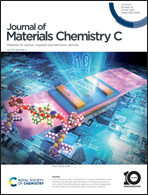Tuning quantum capacitance in 2D graphene electrodes: the role of defects and charge carrier concentration†
Abstract
Even though graphene has been intensively applied in electrochemical devices, the effects of oxidation and how the presence of graphene structural defects interferes with the monolayer graphene electrode–aqueous electrolyte interface remains unclear. Here, we investigate the role of structural defects in the quantum capacitance at the interface between a graphene monolayer and the aqueous electrolyte solution, where the graphene was gradually oxidized by a temporal-controlled electrochemical procedure. We show that the quantum capacitance of graphene can be modulated by tuning the electronic properties, which resulted in a three-fold increase from a value of 3.83 μF cm−2 for the pristine graphene up to 11.11 μF cm−2 for the structurally modified monolayers. A strong correlation is observed between the carrier concentration, density of defects, and quantum capacitance. We suggest that the control of such properties can modulate the performance of graphene-based electrochemical devices according to application.

- This article is part of the themed collection: #MyFirstJMCC


 Please wait while we load your content...
Please wait while we load your content...